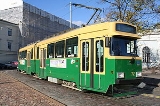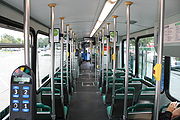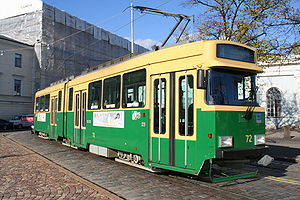
Valmet Nr II
Encyclopedia
Nr II is a class of articulated six-axle (B'2'B' wheel arrangement
), chopper
-driven tram
operated by Helsinki City Transport
(HKL) on the Helsinki tram
network. All trams of this type were built by the Finnish
metal industry corporation Valmet
between the years 1983 and 1987.
Between 1996 and 2005 all trams in the class were modernised by HKL and redesignated as Nr II+ class. From 2006 onwards all trams of this class will be rebuilt with a low-floor midsection. The units rebuilt with low-floor midsection are also known with the class designation MLNRV.
class built by Valmet for the HKL between 1973 and 1975 (the Nr I was in turn based on the popular Düwag-built GT6 class). The Nr I and Nr II classes are virtually identical in their exterior and interior designs.
The first three Nr II class trams were delivered to HKL in 1983, followed by and additional 11 in both 1984 and 1985, further ten in 1986 and the final seven in 1987. The first tram in the class entered service for HKL in July 1983. Between 1996 and 2005 all trams in this class were modernised with updates to the technics, changes to the interior layout, addition of electronic displays displaying the name of the next stop, as well as replacement of the original seats with new ones. Following the modernisation the class was re-designated as Nr II+.
On July 21, 2003, one of the Nr II class trams derailed at high speed in the junction between Mannerheimintie and Aleksanterinkatu in central Helsinki and collided with a motorcycle
, which resulted in the death of the motorcyclist. Investigation into the causes of the accident revealed that the driver of the tram had lost consciousness shortly before the collision due to the extreme heat in the cockpit
of the tram. As a result of the accident the HKL redesigned the windshield of the Nr II class trams, adding a large vizor that contains an air-conditioning unit as well as shields the driver from direct sunlight. Trams 72, 95 and 109 were refitted with modified windshields in 2005. As of March 2009 they remain the only units with a rebuilt windshield.
 Between 2004 and 2007 all trams in the class were built with new line displays in the front and side of the tram, displaying both the number and destination on the line. In 2006 tram number 80 was rebuilt with a new 6.5 metre low-floor midsection, built by Verkehrs Industrie Systeme. As a result of the lengthening the tram has a B'2'2'B' wheel arrangement and can accommodate 30 additional passengers. To cope with the added weight of the midsection, the output of the traction motors was increased by approximately 20%. Experiences with the prototype lengthened tram were positive, and the rest of the Nr II class will be similarly rebuilt from late 2008 onwards. As of November 2009 numbers 76, 80, 85, 86, 91, 98, 99, 101, 102, 110, 111 and 102 have been rebuilt with low-floor midsections.
Between 2004 and 2007 all trams in the class were built with new line displays in the front and side of the tram, displaying both the number and destination on the line. In 2006 tram number 80 was rebuilt with a new 6.5 metre low-floor midsection, built by Verkehrs Industrie Systeme. As a result of the lengthening the tram has a B'2'2'B' wheel arrangement and can accommodate 30 additional passengers. To cope with the added weight of the midsection, the output of the traction motors was increased by approximately 20%. Experiences with the prototype lengthened tram were positive, and the rest of the Nr II class will be similarly rebuilt from late 2008 onwards. As of November 2009 numbers 76, 80, 85, 86, 91, 98, 99, 101, 102, 110, 111 and 102 have been rebuilt with low-floor midsections.

Wheel arrangement
In rail transport, a wheel arrangement is a system of classifying the way in which wheels are distributed beneath a locomotive.. Several notations exist to describe the wheel assemblies of a locomotive by type, position, and connections, with the adopted notations varying by country...
), chopper
Chopper (electronics)
A chopper circuit is used to refer to numerous types of electronic switching devices and circuits. The term has become somewhat ill-defined, and as a result is much less used nowadays than it was perhaps 30 or more years ago....
-driven tram
Tram
A tram is a passenger rail vehicle which runs on tracks along public urban streets and also sometimes on separate rights of way. It may also run between cities and/or towns , and/or partially grade separated even in the cities...
operated by Helsinki City Transport
Helsinki City Transport
Helsinki City Transport or HKL is the official city-owned public transport company in Helsinki, Finland. It operates the Helsinki metro, Helsinki tram and ferry boat traffic...
(HKL) on the Helsinki tram
Helsinki tram
The Helsinki tram network forms part of the Helsinki public transport system organised by Helsinki Regional Transport Authority and operated by Helsinki City Transport in the Finnish capital city of Helsinki. The trams are the main means of transport in the city centre. 56.6 million trips were made...
network. All trams of this type were built by the Finnish
Finland
Finland , officially the Republic of Finland, is a Nordic country situated in the Fennoscandian region of Northern Europe. It is bordered by Sweden in the west, Norway in the north and Russia in the east, while Estonia lies to its south across the Gulf of Finland.Around 5.4 million people reside...
metal industry corporation Valmet
Valmet
' was a Finnish state-owned conglomerate. Valmet was formed in 1951, when the state of Finland decided to group their various factories working on war reparations to the Soviet Union under one company...
between the years 1983 and 1987.
Between 1996 and 2005 all trams in the class were modernised by HKL and redesignated as Nr II+ class. From 2006 onwards all trams of this class will be rebuilt with a low-floor midsection. The units rebuilt with low-floor midsection are also known with the class designation MLNRV.
History
The Nr II class was a further development of the Nr IValmet Nr I
Nr I is a class of articulated six-axle , chopper-driven tram operated by Helsinki City Transport on the Helsinki tram network...
class built by Valmet for the HKL between 1973 and 1975 (the Nr I was in turn based on the popular Düwag-built GT6 class). The Nr I and Nr II classes are virtually identical in their exterior and interior designs.
The first three Nr II class trams were delivered to HKL in 1983, followed by and additional 11 in both 1984 and 1985, further ten in 1986 and the final seven in 1987. The first tram in the class entered service for HKL in July 1983. Between 1996 and 2005 all trams in this class were modernised with updates to the technics, changes to the interior layout, addition of electronic displays displaying the name of the next stop, as well as replacement of the original seats with new ones. Following the modernisation the class was re-designated as Nr II+.
On July 21, 2003, one of the Nr II class trams derailed at high speed in the junction between Mannerheimintie and Aleksanterinkatu in central Helsinki and collided with a motorcycle
Motorcycle
A motorcycle is a single-track, two-wheeled motor vehicle. Motorcycles vary considerably depending on the task for which they are designed, such as long distance travel, navigating congested urban traffic, cruising, sport and racing, or off-road conditions.Motorcycles are one of the most...
, which resulted in the death of the motorcyclist. Investigation into the causes of the accident revealed that the driver of the tram had lost consciousness shortly before the collision due to the extreme heat in the cockpit
Cockpit
A cockpit or flight deck is the area, usually near the front of an aircraft, from which a pilot controls the aircraft. Most modern cockpits are enclosed, except on some small aircraft, and cockpits on large airliners are also physically separated from the cabin...
of the tram. As a result of the accident the HKL redesigned the windshield of the Nr II class trams, adding a large vizor that contains an air-conditioning unit as well as shields the driver from direct sunlight. Trams 72, 95 and 109 were refitted with modified windshields in 2005. As of March 2009 they remain the only units with a rebuilt windshield.

Future
The Nr II class are expected to remain in service at least until 2025.

